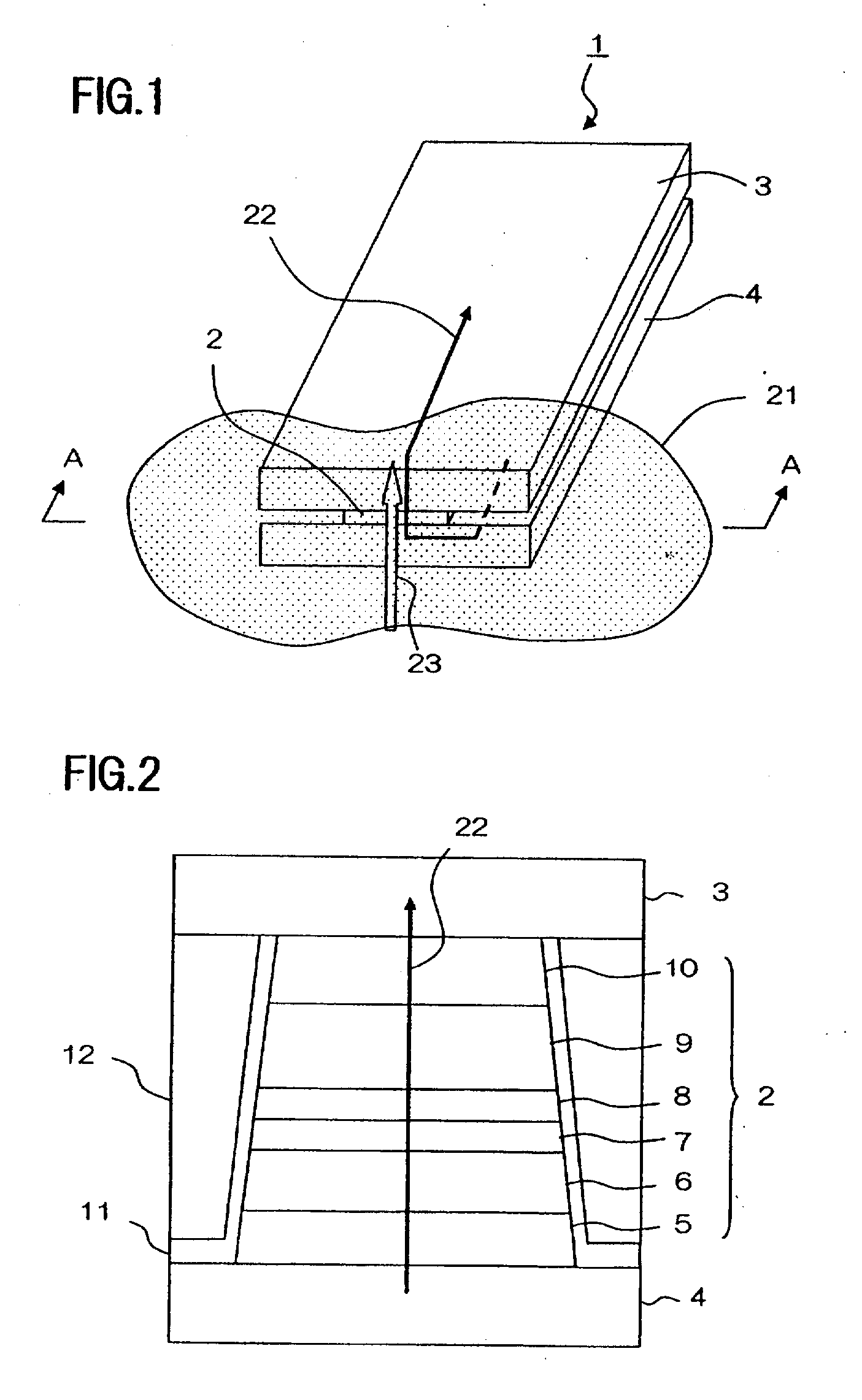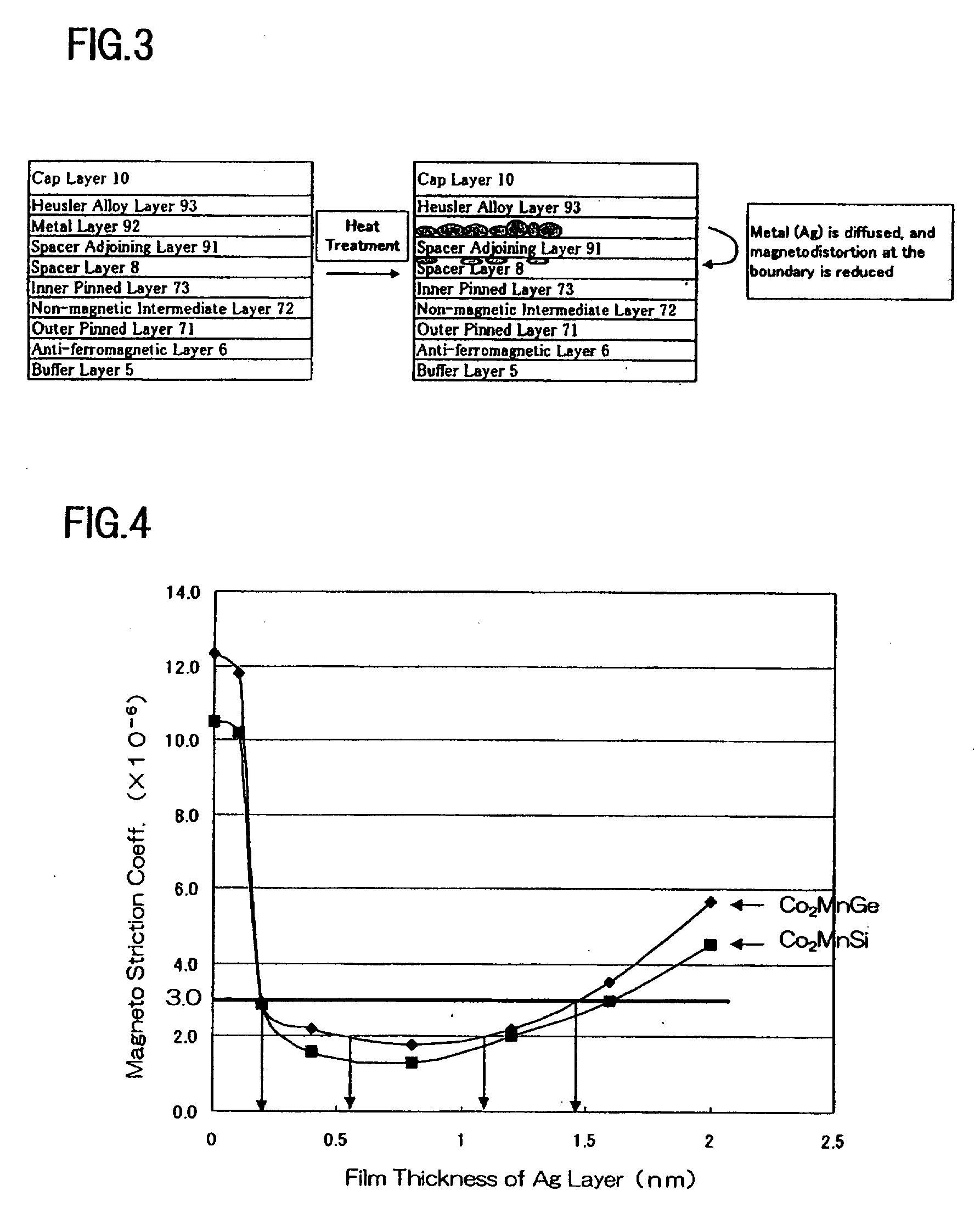Method for manufacturing magnetic field detecting element, utilizing diffusion of metal
a magnetic field and detecting element technology, applied in the field of magnetic field detecting elements, can solve the problem of limited magnetic striction at the boundary, and achieve the effect of low magnetic striction and large mr ratio
- Summary
- Abstract
- Description
- Claims
- Application Information
AI Technical Summary
Benefits of technology
Problems solved by technology
Method used
Image
Examples
experiment 1
(Experiment 1)
[0047]First, influence of the thickness of metal layer 92 on magneto striction and the MR ratio were investigated. Silver was used for metal layer 92. Co2MnSi and Co2MnGe were used for Heusler alloy metal 93, and CoFe was used for spacer adjoining layer 91. As shown in Table 3 and FIG. 4, the magneto striction coefficient was limited to less than +3×10−6 by inserting a silver layer having a thickness of approximately 0.2 nm or more, whereas the magneto striction coefficient exceeded +10×10−6 when a silver layer was not provided. The inventors think that this is because magneto striction is reduced at the boundary between spacer adjoining layer 9 and Heusler alloy layer 93 because of the effect of inserting a silver layer, as mentioned above. However, the magneto striction coefficient was found to be increased again when the thickness was further increased. This is because a large amount of silver remains in the silver layer due to excessive thickness of the silver laye...
experiment 2
(Experiment 2)
[0048]An experiment that is similar to Experiment 1 was conducted using gold for metal layer 92. As shown in Table 4 and FIG. 5, the magneto striction coefficient was more than +10×10−6 when a gold layer was not provided. However, the magneto striction coefficient was less than +3×10−6 when a gold layer having a thickness of approximately 0.2 nm or more was inserted. However, as the thickness was further increased, the magneto striction coefficient was found to be increased again. In this way, the general tendency was similar to the case in which silver was used. In order to achieve magneto striction coefficient that is no more than 3×10−6 in the case of Co2MnSi and Co2MnGe, the thickness of the gold layer has to be equal to or more than 0.2 nm and equal to or less than 1.4 nm. Further, in order to achieve a magneto striction coefficient that is no more than 2×10−6, the thickness of the gold layer has to be equal to or more than 0.3 nm and equal to or less than 1.1 nm....
experiment 3
(Experiment 3)
[0049]Although 70CoFe was used for spacer adjoining layer 91 in Experiments 1 and 2, the influence of the composition of CoFe on the magneto striation coefficient was evaluated by varying the composition of CoFe as a parameter in this experiment. Silver was used for metal layer 92, and gold was also used in some cases. The thickness of the silver layer was evaluated in three cases, i.e., 0 nm (silver was not provided), 0.4 nm, and 0.8 nm. In each case, the atomic percent of Co was varied from 70% to 90% in increments of 5%. Investigations were also conducted for some cases in which the Heusler alloy layer was made of Co2MnGe, and for a case in which the thickness of the silver layer was 1.2 nm. Table 5 and FIGS. 6, 7 show the result of Experiment 3. FIG. 6 is a graph showing the magneto striction coefficient in relation to the atomic percent of Co, which is shown in the horizontal axis, when metal layer 92 was made of a silver layer having a thickness of 0 to 0.8 nm, a...
PUM
| Property | Measurement | Unit |
|---|---|---|
| thickness | aaaaa | aaaaa |
| thickness | aaaaa | aaaaa |
| thickness | aaaaa | aaaaa |
Abstract
Description
Claims
Application Information
 Login to View More
Login to View More - R&D
- Intellectual Property
- Life Sciences
- Materials
- Tech Scout
- Unparalleled Data Quality
- Higher Quality Content
- 60% Fewer Hallucinations
Browse by: Latest US Patents, China's latest patents, Technical Efficacy Thesaurus, Application Domain, Technology Topic, Popular Technical Reports.
© 2025 PatSnap. All rights reserved.Legal|Privacy policy|Modern Slavery Act Transparency Statement|Sitemap|About US| Contact US: help@patsnap.com



